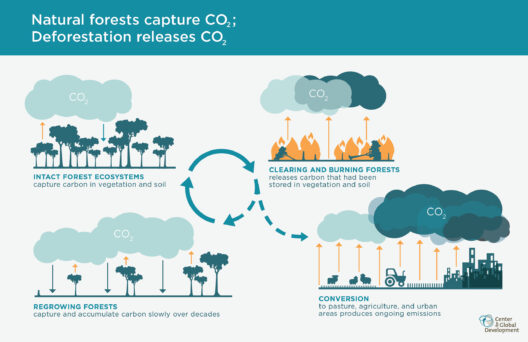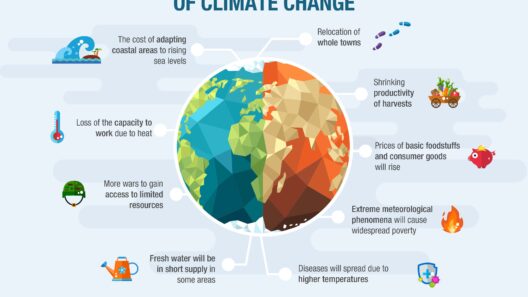Climate change and biodiversity are inextricably linked, presenting a dual challenge that requires urgent attention. The intricate web of life on Earth consists of millions of species, each playing a vital role in maintaining ecological balance. As temperatures rise, habitats shift, and ecosystems become destabilized, one must ponder: how can biodiversity serve as a frontline defense against the insidious threat of global warming?
The term “biodiversity” encapsulates the plethora of living organisms found in various ecosystems—ranging from the vastness of the ocean to the depths of the rainforest. This rich tapestry of life is not merely a collection of species; rather, it represents an essential foundation for human survival and well-being. As ecosystems flourish, they provide numerous services crucial to sustaining life—clean air, fresh water, pollination of crops, and carbon sequestration, to name a few. In this intricate dance of life, the extinction of even a single species can have reverberating effects throughout the food web.
However, as climate change accelerates, species are finding it increasingly difficult to adapt to the shifting conditions of their environments. The temperature rise and erratic weather patterns disrupt migration routes, breeding seasons, and food availability. Consider the plight of the polar bear, which relies on sea ice for hunting seals. As ice caps melt, the bears are faced with diminishing hunting grounds, leading to perilously low populations. This daunting scenario exemplifies a broader ecological crisis: the fragility of various species and their habitats is underscored by the unrelenting advance of climate change.
Yet, rather than succumbing to despair, there lies a compelling opportunity to explore how biodiversity can combat global warming. Ecosystems function optimally when they are diverse, and this diversity enhances resilience. Think of forests, those towering sentinels of the natural world. They absorb significant amounts of carbon dioxide, acting as vital carbon sinks. A diverse forest, teeming with myriad species, can maintain ecological stability while maximizing carbon sequestration. Therefore, protecting and restoring these biodiverse habitats presents one of the most significant opportunities for mitigating climate change.
Transitioning to sustainable agricultural practices offers another avenue for harnessing biodiversity in the fight against global warming. Industrial agriculture, characterized by monoculture and heavy chemical use, has devastating consequences for both ecosystems and the climate. By embracing agroecology—an approach that prioritizes biodiversity and natural processes—farmers can create resilient agricultural systems that minimize reliance on fossil fuels and synthetic fertilizers. Crop rotation, companion planting, and agroforestry not only enhance soil health but also create microhabitats for various organisms, fostering a healthier ecosystem that can withstand climatic shocks.
In addition to forests and agriculture, wetlands serve as another crucial component of our biodiversity arsenal. These verdant ecosystems are not only significant carbon sinks but also critical for water filtration, flood protection, and habitat provision. The preservation of wetlands counters climate change by sequestering carbon and providing a buffer against extreme weather events. Restoring degraded wetlands also has immense potential to enhance biodiversity, offering refuge for countless species that have lost their habitats due to urbanization and industrialization.
The interconnectedness of climate change and biodiversity extends even to the ocean. Marine ecosystems are under threat from ocean acidification, rising sea temperatures, and overfishing, which threaten the very fabric of aquatic life. Coral reefs, often dubbed the “rainforests of the sea,” harbor unparalleled biodiversity and require urgent protection. They not only serve as breeding grounds for numerous marine species but also protect coastlines from erosion. By mitigating climate change, we stand to preserve these vibrant underwater landscapes and the myriad species they support.
However, the task of safeguarding biodiversity in the face of climate change presents a formidable challenge. As human activities expand, habitat loss and degradation intensify, threatening not only plant and animal life but also our own survival. Restoration of ecosystems and habitats requires comprehensive approaches that engage local communities, policymakers, and businesses alike. Such collaboration ensures that conservation efforts are effective and inclusive.
As we navigate this critical juncture, investing in renewable energy sources is an imperative step towards reducing greenhouse gas emissions and protecting biodiversity. Wind, solar, and hydroelectric power offer cleaner alternatives to fossil fuels, thus lessening the burden on our ecosystems. Transitioning to a renewable energy economy not only addresses climate change but also empowers communities through job creation and economic growth.
In summation, biodiversity serves as a critical ally in the battle against global warming. Its capabilities to regulate carbon, stabilize ecosystems, and foster resilience against climate-related shocks underline its indispensable role in climate mitigation efforts. The interplay between climate and biodiversity encapsulates a complex challenge—a defining conundrum of our time. As stewards of this planet, the responsibility lies with us to protect and restore the diverse ecosystems that sustain life. The choices we make today will resonate through generations, shaping the legacy we leave for future inhabitants of Earth.





